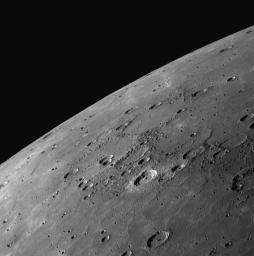
|
Extensive Smooth Plains on Mercury
- Click the image above for a larger view
- Full-Res JPEG (1018 x 1024) (106.2 kB)
- Full-Res TIFF (1018 x 1024) (1.0 MB)
Caption:
This NAC image is of an area just to the north of a previously released image acquired during MESSENGER's third flyby of Mercury. Both that previously released image and this one show large areas of Mercury's surface that appear to have been flooded by lava. In this view, craters are visible that have been nearly filled with lava, leaving only traces of their circular rims. MESSENGER images have revealed that the smooth plains in this region of Mercury's surface are quite extensive, and MESSENGER Science Team members are currently updating maps of the smooth plains created after the mission's second Mercury flyby to include these new views obtained from Mercury flyby 3. After the Mariner 10 mission, there was some controversy concerning the extent to which volcanism had modified Mercury's surface. Now MESSENGER results, including color composite images , evidence for pyroclastic eruptions , and images of vast lava plains (such as shown here) have demonstrated that Mercury was indeed volcanically active in the past.
Date Acquired:
September 29, 2009
Image Mission Elapsed Time (MET):
162744010
Instrument:
Narrow Angle Camera (NAC) of the Mercury Dual Imaging System (MDIS)
Resolution:
410 meters/pixel (0.25 miles/pixel)
Scale:
The bottom of this image is about 420 kilometers (260 miles) across
Spacecraft Altitude:
16,200 kilometers (10,100 miles)
Background Info:
These images are from MESSENGER, a NASA Discovery mission to conduct the first orbital study of the innermost planet, Mercury. For information regarding the use of images, see the MESSENGER image use policy .
Cataloging Keywords:
| Name | Value | Additional Values |
|---|---|---|
| Target | Mercury | |
| System | ||
| Target Type | Planet | |
| Mission | MESSENGER | Mariner |
| Instrument Host | MESSENGER | Mariner 10 |
| Host Type | Orbiter | Flyby Spacecraft |
| Instrument | Mercury Dual Imaging System (MDIS) | |
| Detector | Narrow Angle Camera (NAC) | |
| Extra Keywords | Crater, Grayscale, Volcano | |
| Acquisition Date | ||
| Release Date | 2010-01-13 | |
| Date in Caption | 2009-09-29 | |
| Image Credit | NASA/Johns Hopkins University Applied Physics Laboratory/Carnegie Institution of Washington | |
| Source | photojournal.jpl.nasa.gov/catalog/PIA12421 | |
| Identifier | PIA12421 | |
